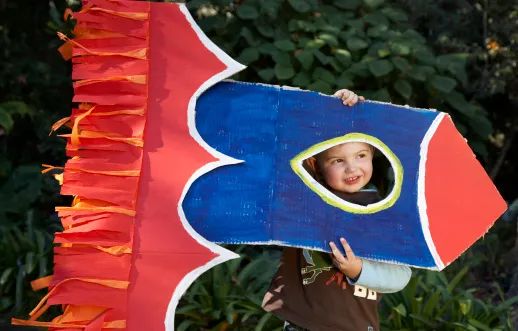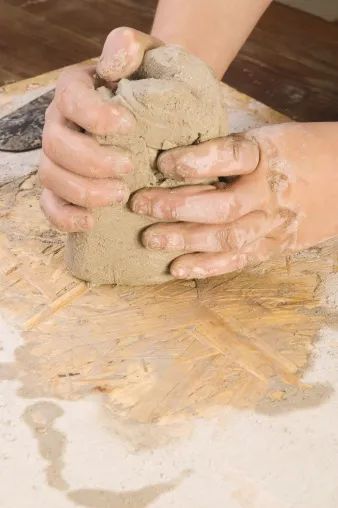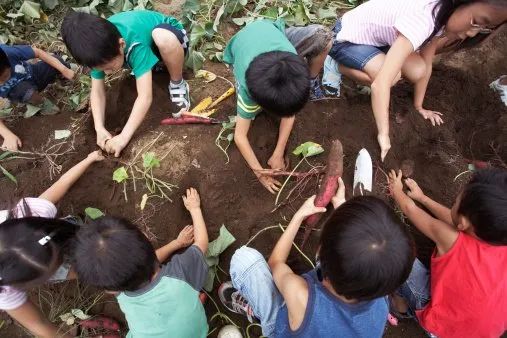Creativity in Montessori
“The things he sees are not just remembered; they form a part of his soul.” –Maria Montessori

Most parents hope that their child’s environment will be one that encourages creativity. We delight in the sight of our child pulling on an apron and approaching an art easel stocked with beautiful paints and fresh paper. We giggle over their early stick figure drawings, celebrating that time they first add fingers and eyelashes to their portrait work. We relish the sound of them singing Twinkle, Twinkle to us with adorable hand motions from the back seat of the car.
But as the child exhausts the resources of the home, parents start to consider ways of expanding their opportunities. Montessori teachers know that creativity starts with a well-prepared environment, mindful that children absorb everything around them. When Montessori teachers talk about the Prepared Environment, we work from a foundation of physical and emotional safety, valuing the well-being of every child. We know we cannot expect children to flourish and expand themselves creatively in an unsafe atmosphere, whether physically or emotionally. Much of this is connected to the classroom culture that the teacher nurtures through role modeling and using the best of her early-childhood training to support social development for her whole class.
 Setting the Stage
Setting the Stage

In order to provide exceptional spaces with the very best materials, Montessorians prefer an using wood and natural fibers in the furniture and materials that feel organized, yet natural, softly colorful, comfortable and welcoming in a homey way. The ideal environment includes a floor plan that allows for movement, spaces where children can work together or independently, and organized supplies and materials for ease of use and clean-up.
The children are allowed to explore the educational materials and art media with freedom that is tempered by a care that is born of a sense of responsibility to others, as well as a love for their "work." The classroom environment is thoughtfully organized with activities including music, movement and artistic media which are organized in such a way as to welcome the child to help himself to without having to ask for, search for, or be hovered over while he explores the textures, colors, and possibilities inherent within the materials made available to him.
Most Montessori classrooms I have visited contain a vibrant art area and projects that includes an array of opportunities such as collage projects, sewing, block printing, beadwork, necklace making, clay work, color mixing, cattle markers on butcher block paper, thumb print art, mobile making...the variations and ideas are almost endless.
 Montessori Materials
Montessori Materials

And what of those traditional Montessori materials? Generally teachers demonstrate their use to children individually and some critics question if that allows enough freedom. But if you spend time observing in a classroom, you will see that most of the Montessori materials encourage experimentation and include creative variations. The teachers present one way to use the lesson as an introduction, but when the child takes their turn and later comes back again and again, they employ a wide range of approaches, using trial and error, and sometimes finding shortcuts in their work. They might consult each other for ideas, collaborating on tasks such as matching collected tree leaves to the puzzle materials in the classroom, building a floor maze with colored rods or checking on the progress of recent science experiment. Individual and small-group instruction allow us to invite children to otherwise often discouraged activities such as cutting with child-safe scissors, using vegetable peelers, graters and other kitchen items. Part of the teachers’ lesson planning process includes watching for the child’s developing fine motor skills before introducing these new skills, and carefully monitoring the child’s safe use of such items. Parents are often amazed to see how accomplished their children become with food preparation activities at tender ages in the Montessori environment.

Children may also dictate or write down their own stories and illustrate them. At my school, this is an activity parents often help with in the classroom as they get to transcribe the stories that pre-writing children relate, often employing great imagination. Meanwhile, other children may build towers of cylinders or match color tablets to objects around them, while some may discover the beautiful patterns within mathematical layouts of colored beads. In other parts of the classroom children color in maps of various continents and label them with the geographic names. Another favorite activity might include filling vases with fresh floral arrangements that are lovingly scattered around the various small tables on crocheted doilies.
Outside
Stepping outside, one might find wood-working, sculpture making, flower pressing, stepping stones and mosaic art, petal pounding, fort building from recycled materials, as well as a host of gardening activities. Children can dig, water, weed, harvest and feel productive as contributors to these magical areas of gardens and grounds.

On the playground, children often enjoy their own play houses and create imaginative games where they can sample different roles to play together. They enjoy group games, parachute play, loading toy dump trucks with sand or gravel, and water play at the water table. Or they may opt to shovel sidewalks, pull each other in wagons, create murals with sidewalk chalk or reorganize a jumbled collection of balls.
The Social Side of Creativity
In group activities, children enjoy storytelling and music, learn folk dances and sing songs centered around seasonal themes. Role play to work out social development scenarios might include puppet shows or small plays for each other or their parents. At the peace pole, a conflict resolution tool, they take turns sharing their stories and seeking to regain safety and trust as they move through the ups and downs of community together. Teachers resist the urge to spoon-feed solutions in order to make room for the longer, often messier, but more rewarding process of allowing children to come up with their own ideas. Creative problem solving is an important component of any program, allowing for the children to nurture their own sense of efficacy in the world.
The teachers that I have been fortunate to rub shoulders with are proud of the way their children light up as they walk into these colorful environments each morning and set about to care for them through watering plants, hanging up their own art, preparing and baking bread, feeding pets, sweeping the floor and "keeping house" as if it their spaces are their own home away from home. In this world, the child's entire environment helps them to create themselves through a tapestry of meaningful experiences that make for optimal learning and growth.

Rich Rewards
In a smaller city it is easy to follow the successes of our alumni students as they move on to greater adventures. The long-term benefits of the Montessori approach manifest in the highly creative talents of our alumni kids as they courageously perform in plays, ballets, sell their handmade jewelry at the Farmer’s Market, contribute to the high school paper, show their paintings and sculpture in art openings and perform at musical gatherings.
Yes, Montessori does allow for creativity, through carefully setting the stage and nurturing each child to blossom in their own way, in their own time.
Some Montessori Alumni in the Arts:
- Julia Child, chef
- Helen Hunt, actress
- Joshua Bell, Grammy Award winning Violinist
- David Blaine, Illusionist and Magician
- George Clooney, Actor
- Anthony Doer, Author
- Friedensreich Hundertwasser, Viennese artist & architect
- Beyonce Knowles, Singer
- Will Wright, Video Game Pioneer






















